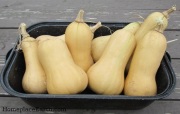Saving your own seeds is a wonderful thing to do, but it is something you should plan for early in the growing season. If you know you will be saving seeds, make sure the varieties of each crop you will be saving from do not have a chance to cross pollinate with other varieties of the same crop. There are charts online and in seed saving books that give isolation distances for each crop—the distance varieties must be separated to avoid cross pollination. The distance might be shortened if there are barriers present, such as trees or shrubs and solid fences. Having a hedge as a boundary around your garden would decrease the distance you have to be from your neighbor’s garden to avoid cross pollination.
You could use time as an isolation method. Plants that have a limited blooming period can be managed so that the flowering of different varieties doesn’t happen at the same time. For example, on the same day you could plant two varieties of corn that have at least two weeks difference in their dates to maturity. The pollen from the first variety will have finished by the time the pollen is released from the later maturing variety. Or, you could plant two varieties of corn with the same dates to maturity, but space the planting times two weeks apart.
Some growers resort to using bags or screened cages to keep their crops from cross pollinating and some even resort to hand pollinating. Hand pollination is sometimes done with flowers in the squash family—the cucurbits. I’ve never had the patience to watch for female flowers to open, then pollinate them with pollen collected from the male flowers of the plant. The fertilized flowers would then be taped shut. If I intend to save seeds from squash crops I only plant one variety in each species in the genus Cucurbita. Although there are six species, I’ve only encountered four: Cucurbita maxima, C. mixta, C. moschata, and C. pepo. You can grow one variety of each species at the same time without worrying about cross pollination. A good seed catalog will indicate which species a squash variety belongs to.
Have goals in mind for what you are selecting for. When you are first starting out you might be happy to save any seeds at all. Collecting from as many plants as possible will give you a broader range of genetics; however, you might want to select for certain traits, such as earliness, lateness, taste, shape, size or color. If you save seeds from the plants that produce the first tomatoes of the season, you are selecting for earliness. Those plants may or may not be the same plants that produce tomatoes the longest into the season. Pay attention to what drives you to choose the plants to save from. Sometimes you will notice a plant that is doing exceptionally well, but it is not the right time to save seeds yet. Tag that plant that has the characteristics you want to preserve so you can identify it when the right time to save seeds occurs.
When tomatoes and peppers are harvested at full ripeness for eating, their seeds are mature and can be readily saved. For summer squashes and cucumbers, you would need to leave the vegetables on the plant until they are overgrown and way past the time to harvest for eating. Still other crops need to be left over the winter, saving the seeds when the plants flower the following year. The extra time for these plants to be in your garden needs to be accounted for in your garden plan.
The kale and collards you might have harvested for food for the table through the winter will be vacating your garden bed in March when they begin to bolt. However, if you are saving seeds from them, they may occupy that space until June. Only let one variety of cabbage family plants flower and go to seed at a time to avoid cross pollination. Before the variety you are saving from begins to flower, you should have begun to choose which plants you want to save seeds from. Most likely, the first to flower won’t be among your choices, nor will the plants that produced the least foliage to harvest through the winter. Pulling those plants out first leaves more room for the others and is part of the selection process.
Seed saving is a way to deepen your gardening experience and is an adventure that you can share with others through your neighborhood seed library. If your seeds are destined to be shared through a seed library, you will want to make sure that what you are sharing is what you say it is and hasn’t cross pollinated with anything else. If you don’t have a seed library in your neighborhood you may want to start one. You will find guidance for that project in my book Seed Libraries and Other Means of Keeping Seeds in the Hands of the People.
Seed libraries have been evolving at a rapid pace. Those who have been involved in that evolution will be coming together to study the issue at the First International Seed Library Forum in Tucson, Arizona, May 3-6. I’m looking forward to being one of the panelists for that event. You never know where your seed saving hobby will take you.











